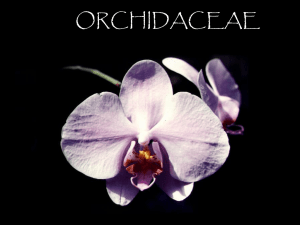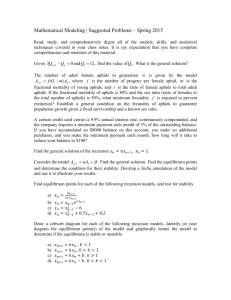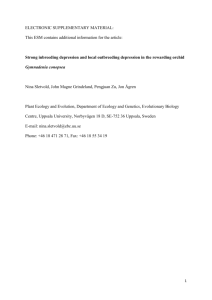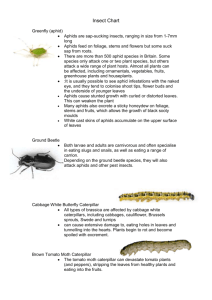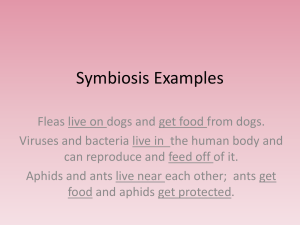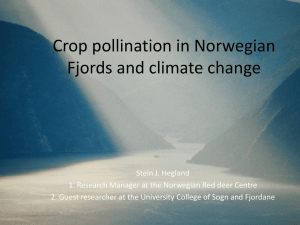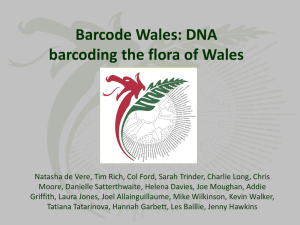file - BioMed Central
advertisement
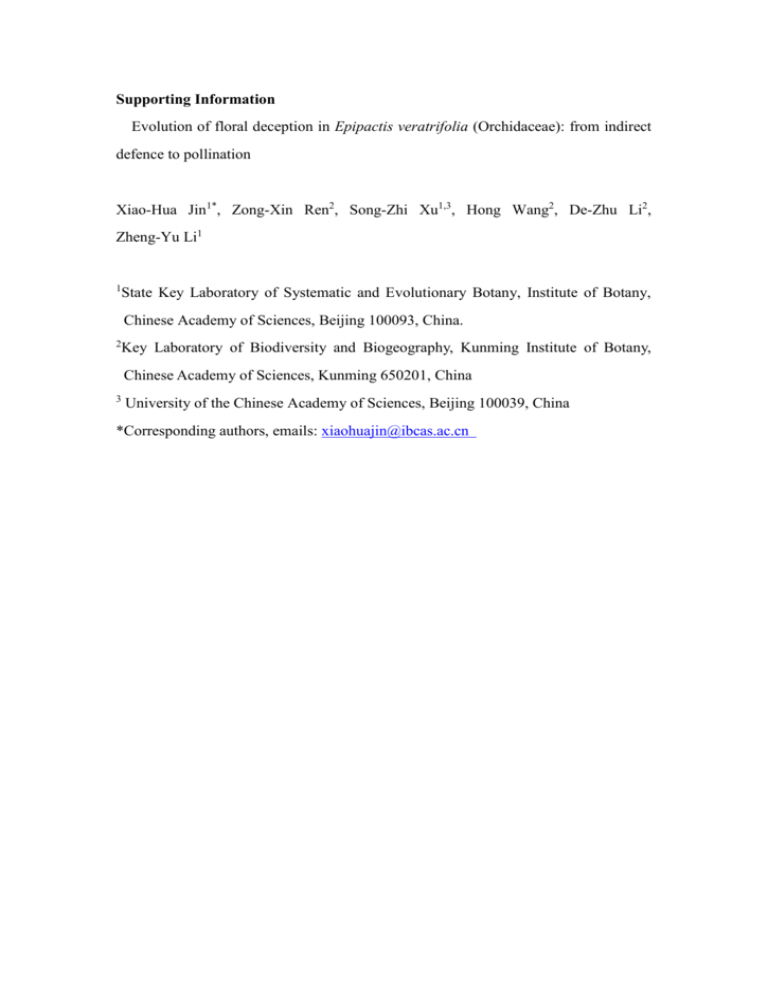
Supporting Information Evolution of floral deception in Epipactis veratrifolia (Orchidaceae): from indirect defence to pollination Xiao-Hua Jin1*, Zong-Xin Ren2, Song-Zhi Xu1,3, Hong Wang2, De-Zhu Li2, Zheng-Yu Li1 1 State Key Laboratory of Systematic and Evolutionary Botany, Institute of Botany, Chinese Academy of Sciences, Beijing 100093, China. 2 Key Laboratory of Biodiversity and Biogeography, Kunming Institute of Botany, Chinese Academy of Sciences, Kunming 650201, China 3 University of the Chinese Academy of Sciences, Beijing 100039, China *Corresponding authors, emails: xiaohuajin@ibcas.ac.cn Molecular Phylogenetics and the evolution of pollination systems of Epipactis A total of 20 species (Table S5), representing two sections; sect. Epipactis and sect. Arthrochilium, were included. Three samples of Epipactis veratrifolia were used. Outgroups included five species from tribe Neottieae (Orchidoideae; Orchidaceae). We sequenced chloroplast rbcL, matK and nuclear ITS markers. Voucher information and GenBank accession numbers are listed in Table S5. Total genomic DNA was isolated from silica-gel-dried materials using a Plant Genomic DNA Kit (Beijing Biomed Co., LTD, Beijing, China). The PCR primers for matK, rbcL, and ITS are listed in Table S6. The selected DNA regions were amplified by using a standard polymerase chain reaction (PCR). The sequencing reactions were performed by using the ABI Prism Bigdye Terminator Cycle Sequencing Kit (Applied Biosystems, ABI). Sequences were aligned using the default parameters in Clustal X version 1.83 [1] and manually adjusted with BioEdit version 5.0.9 [2]. Phylogenetic analyses for the combined dataset were carried out using parsimony (PAUP version 4.0b10) [3], and Bayesian inference (BI; MrBayes version 3.1.2) [4]. The homogeneity between the nrDNA ITS data and the combined plastid dataset (rbcL and matK) was tested using the incongruence length difference (ILD) test (Farris et al., 1995), implemented in PAUP version 4.0b10[3]. For MP, parsimony heuristic searches were performed with 1000 random sequence addition replicates, tree-bisection-reconnection (TBR) branch swapping, MulTrees in effect. Steepest descent was not used. Internal branch support under MP was estimated by using 1000 bootstrap (BS) replicates. For BI, the analysis was performed with two runs, each having four chains, with trees and parameters sampled every 1000th generation. Burn-in and convergence were assessed using the likelihood of the runs plotted against generations using Tracer version 1.5 (http://beast.bio.ed.ac.uk/Tracer). Trees were summarized after removing the burn-in samples. Finally, a 50% majority-rule consensus tree was built in MrBayes. Pollination systems of Epipactis were investigated using published books, Google Scholar and Web of Sciences [5-14] . In total, pollination systems of nine species have been investigated previously and were included in the analysis (Table S7). The ancestral systems of Epipactis were reconstructed under a maximum parsimony approach in Mesquite version 2.74. (http://mesquiteproject.org/mesquite/mesquite.html). This data set included nrITS and plastid (rbcL and matK) for 29 taxa. The ITS dataset consisted of 631 characters of which 86 (19.2%) were parsimony informative, and the chloroplast dataset consisted of 2919 characters of which 35 (0.1%) were parsimony informative (Table S8). According to the partition homogeneity test, the two datasets were congruent (P = 0.11). Therefore, we combined the two datasets for the phylogenetic analysis. Bayesian trees of each dataset were congruent with the MP strict tree, except for the weakly supported nodes. Epipactis was monophyletic with strong support (Posterior Probabilities = 1.00, Bootstrap = 100). Despite the morphological similarities within sect. Arthrochilum this section was paraphyletic. Epipactis veratrifolia and E. flava of sect. Arthrochilium formed a well resolved clade that was the sister to the remaining Epipactis species. Sect. Epipactis deeply nested within sect. Arthrochilum and was supported as a monophyletic clade (PP = 1.00, BS = 95) (Figure 5). Volatile collections and analysis Floral scent was collected in the field at 14:00 using dynamic headspace adsorption methods in SL in 2011. One inflorescence with newly opened flowers that was free from aphids was enclosed in a polyethylene terepthalate bag (25 × 38 cm; Sainsbury’s Supermarkets). Two holes were cut at opposite ends of the bag. One hole was fitted with an activated carbon filter (Supelco) for air intake, and the other was fitted with a Super-Q volatile collection trap (Analytical Research Systems) containing 30 mg of Alltech Super-Q adsorbent material. Each flower was enclosed for 2h, after which the flower headspace was sampled with two micropumps driven by a portable battery. Constant airflow was adjusted to 100 mL/min using a flow meter. The sampling periods were 3–4 h. Empty cooking bags placed in close proximity to the flower were sampled as controls. After fragrance sampling, adsorbed volatiles were eluted from the Super-Q with 0.15 mL of dichloromethane (Uvasol; Merck). Samples were sealed in glass vials and stored at −20 °C. The volatiles were analyzed on a Hewlett-Packard 6890 Series GC System coupled to a Hewlett-Packard 5973 Mass Selective Detector using an Agilent 7683 Series Automatic Liquid Sampler. An HP-5MS column (5% phenylmethylpolysiloxane; 60 m long, 0.32 mm inner diameter, 0.25 μm film thickness; Agilent) was used for the analyses. Electronic flow control was used to maintain a constant helium gas flow of 1.4 mL/min. The GC oven temperature began at 50 °C and was increased by 5 °C/min to 100 °C and held for 10 min, then increased by 5 °C/min to 280 °C and held for 5 min. The MS interface was 280 °C, and the ion trap was activated at 150 °C. The mass spectra were taken at 70 eV (in EI mode) with a scanning speed of 1 per scan from m/z 35–550. Component identification was performed using the Wiley NIST 05 mass spectral database and Wiley 7. Table S1 Locality of each population ( elevation, m; population size, plants/inflorescences, data collected in May, 2012) Population Song-ta (ST) Shuan-la(SL) Ben-dan-qiao (BDQ) Ben-dan (BD) Pu-la-ding (PLD) Ma-ji (MJ) Shi-yue-liang (SYL) Shan-pa (SP) Jia-ke-ding (JKD) Pi-he(PH) Latitude Longitude 28°09′ 56.76″N 27°59′ 02.00″N 27°53′ 40.67″N 27°48′ 05.89″N 27°34′ 31.61″N 27°31′ 06.17″N 27°20′ 36.36″N 26°57′ 16.73″N 26°46′ 14.85″N 26°40′ 52.55″N 098°29′00.88″E Elevation (m) 1650 098°39′10.84″E 1539 098°40′31.70″E 1479 098°41′02.03″E 1457 098°48′16.78″E 1396 098°49′43.09″E 1364 098°51′10.18″E 1324 098°51′59.30″E 1208 098°53′18.10″E 1154 098°53′50.05″E 1132 size 500 plants, 300 inflorescences 400 plants, 150 inflorescences 100 plants,40 inflorescences 1000 plants, 300 inflorescences 2000 plants, 800 inflorescences 400 plants, 200 inflorescences 500 plants, 300 inflorescences 1000 plants, 300 inflorescences 800 plants, 400 inflorescences 300 plants, 100 inflorescences Table S2 Aphids on plants with budding inflorescence during the first survey (March 7-17, 2012) Populations Aphids Name The number of plants The number of aphids The percent of infection Songta (ST) 100 0 0 Shuanla(SL) 50 0 0 Bendanqiao (BDQ) 22 56 36.3% Bendan (BD) 25 1 4% Pu-la-ding (PLD) 100 234 14% Ma-ji (MJ) 100 31 16% Shi-yue-liang (SYL) 100 36 11% Shan-pa (SP) 100 1 1% Jia-Ke-ding (JKD) 100 68 8% Pi-he(PH) 100 237 11% Table S3 Aphids on plants with blooming inflorescence during the first survey (April 11–13, 2012) Population aphids name The number surveyed plants Songta (ST) No blooming plants Shuanla(SL) No blooming plants Bendanqiao (BDQ) No blooming plants Bendan (BD) No blooming plants Pu-la-ding (PLD) 71 Ma-ji (MJ) No blooming plants Shi-yue-liang (SYL) The number aphids of The percent of infection 504 30.99% 62 51 3.23% Shan-pa (SP) 100 0 0 Jia-Ke-ding (JKD) 100 67 4% Pi-he (PH) 77 9 5.19% Table S4 Aphids on plants with blooming inflorescence during the second survey Population aphids name The number surveyed plants The number of aphids The percent infection Songta (ST) 50 2 4% Shuanla(SL) 50 2 4% Bendanqiao (BDQ) 32 4 6.7% Bendan (BD) 100 18 11% Pu-la-ding (PLD) 100 48 12% Ma-ji (MJ) 100 33 19% Shi-yue-liang (SYL) * * * Shan-pa (SP) 100 3 2% Jia-Ke-ding (JKD) 100 18 7% Pi-he(PH) No blooming plants of *This population was destroyed due to road construction Table S5. Taxa, voucher and GenBank accession numbers of Epipactis used in this study Species Voucher rbcL matK ITS E. albensis E. atrorubens E. duriensis E. fageticola E. flava E. helleborine -Jin Xiaohua, Jin Weitao, Xu Songzhi 13207 (PE) Jin Xiaohua, Jin Weitao, Xu Songzhi 13128 (PE) Jin Xiaohua, Jin Weitao, Xu Songzhi 13284 (PE) Jin Xiaohua 20120623 (PE) Jin Xiaohua 13048 (PE) FPH-0655 (PE) - FJ454878 JX088503 FJ454877 KF419090* JN894244 KF419095* AY154384 JN847403 AY351377 AY351382 FJ454869 KF419100* FJ454879 KF419091* JN894967 KF419096* FJ454870 AY351381 KF419101* JX094818 FJ454881 KF419092* KF419097* FR750399 FJ454871 KF419102* FJ454882 JN891262 JN094816 KF419093* JN896120 JN894394 KF419098* AY146448 JN847412 JN847416 KF419103* JF972911 KF419094* JX903645 KF419099* FR750400 KF419104* KF724436 JN005445 KF727437 JN004425 KF727435 JN114497 - AF074123 JX051381 JX088502 JX051378 JX051379 - JN706691 AY368396 JN896261 EF079303 FJ454867 AY146446 AY369083 AY369084 AY351378 FJ694841 AY351383 E. leptochila E. lustitanica E. mairei E. microphylla E. muelleri E. papillosa E. palustris E. phyllathes E. pseudopurpurea E. purpurata E. roylenana E. thunbergii E. voethii E. veratrifolia (China) E. veratrifolia (Pakistan) E. veratrifolia Outgroups Aphyllorchis sp. Cephalanthera damasonii C. longifolia C. rubra Limodorum abortivum Listera ovata Neottia nidus-avis Note: * represents the data obtained in this study. Table S6 Primers used for amplification in this study Loci Name Sequence (5’-3’) rbcL 1F ATG TCA CCA CAA ACA GAA AC 1360R CTT CAC AAG CAG CAG CTA GTT C 19F CGT TCT GAC CAT ATT GCA CTA TG 390F CGA TCT ATT CAT TCA ATA TTT C trnK-2R AAC TAG TCG GAT GGA GTA G 17SE ACG AAT TCA TGG TCC GGT GAA GTG TTC G 26SE TAG AAT TCC CCG GTT CGC TCG CCG TTA C matK ITS Table S7. Pollination systems of Epipactis and Cephalanthera Species Pollinators Literature Cephalanhera longifolia Solitary bees [15] C. rubra Solitary bees [16] Epipactis atrorubens Bumble-bees [5] E. helleborine Social wasp (parasitic) [6] E. microphylla Autogamy [7] E. muellerie Autogamy [17] E. palustris Facultative autogamy, ants, fly, bee [5, 8, 9] E. purpurata Social wasp (parasitic) [5, 13] E. royleana Hoverflies # E. thunbergii Hoverflies [14] E. veratrifolia Hoverflies [11, 12] # [10] Epipactis gigantea and E. royleana are considered as identical in floral morphology (sensu Rose et al 1999 [18]). Table S8 Statistics from the analyses of the various datasets Data set rbcL matK Taxon Total length 24 1290 15 1429 ITS Three loci 27 29 631 3350 Parsimony-informative characters 20 34 121 175 Model CI RI HKY TVM+I Tree length 125 132 0.960 0.917 0.839 0.838 SYM+G GTR+I+G 297 559 0.781 0.848 0.848 0.845 Figure S1 Habitat and floral organs of Epipactis veratrifolia. a) Habitat of E. veratrifolia along the Salween bank; b) hypochile, epichile, column and anther cap of E. veratrifolia, arrow indicating anther cap;c) Larva on dorsal sepal, aphid on lateral sepal (arrows indicate aphid and larva); d) Aphids and egg on flowers (arrows indicate aphids and egg. For sense of scale, a, the plant in bloom averages 40-60 cm in height; b, the length of anther cap averages 3 mm; c, the dorsal sepal averages 12 mm; d, egg length averages 0.7 mm. Figure S2 Distribution of E. veratrifolia in Eastern Himalayas along Salween. Literature 1. Thompson JD, Gibson TJ, Plewniak F, Jeanmougin F, Higgins DG: The CLUSTALX windows interface: flexible strategies for multiple sequence alignment aided by quality analysis tools. Nucleic Acids Research 1997, 25(24):4876-4882. 2. Hall TA: BioEdit: a user-friendly biological sequence alignment editor and analysis program for Windows 95/98/NT. Nucleus Acids Symposium Series 1999, 41:95-98. 3. Swofford DL: PAUP*: Phylogenetic analysis using parsimony (*and other methods), version 4.0b10. Sunderland, Massachusetts: Sinauer; 2003. 4. Ronquist F, Huelsenbeck, J.P.: MrBayes 3: Bayesian phylogenetic inference under mixed models. Bioinformatics 2003, 19:1572-1574. 5. Jakubska-Busse A, Kadej M: The pollination of Epipactis Zinn,1757 (Orchidaceae) species in entral Europe -the significance of chemical attractants, floral morphology and conconitant insects. Acta Societatis Botanicorum Poloniae 2011, 80(1):49-57. 6. Brodmann J, Twele R, Francke W, Hoelzler G, Zhang Q-H, Ayasse M: Orchids mimic green-leaf volatiles to attract prey-hunting wasps for pollination. Current Biology 2008, 18(10):740-744. 7. Bonatti PM, Sgarbi E, Del Prete C: Gynostemium micromorphology and pollination in Epipactis microphylla (Orchidaceae). Journal of Plant Research 2006, 119(5):431-437. 8. Talalaj I, Brzosko E: Selfing potential in Epipactis palustris, E. helleborine and E. atrorubens (Orchidaceae). Plant Systematics and Evolution 2008, 276(1-2):21-29. 9. Brantjes NMB: Ant, bee and fly pollination in Epipactis palustris (L.) Crantz (Orchidaceae). Acta Botanica Neerlandica 1981, 30(1-2):59-68. 10. van der Cingel NA: An atlas of orchid pollination: America, Afirca, Asia and Australia. Rotterdam, Netherlands: A.A. Balkema; 2001. 11. Ivri Y, Amotes. D: Pollination ecology of Epipactis consimilis Don. (Orchidaceae) in Israel. New Phytologist 1977, 79(1):173-177. 12. Stökl J, Brodmann J, Dafni A, Ayasse M, Hansson BS: Smells like aphids: orchid flowers mimic aphid alarm pheromones to attract hoverflies for pollination. Proceedings of the Royal Society B-Biological Sciences 2011, 278(1709):1216-1222. 13. Ehlers BK, Olesen JM: The fruit-wasp route to toxic nectar in Epipactis orchids. Flora 1997, 192:223-229. 14. Sugiura N: Pollination of the orchid Epipactis thunbergii by syrphid flies (Diptera: Syrphidae). Ecological Research 1996, 11:249-255. 15. Amotes D, Yariv I: The flower biology of Cephalanthera longifolia (Orhidaceae)-Pollen Imitation and Facultative Floral Mimicry. Plant systematics and Evolution 1981, 137:229-240. 16. Nilsson LA: Mimesis of bellflower (Campanula) by the red helleborine orchid Cephalanthera rubra. Nature 1983, 305(27):799-800. 17. Squirrell J, Hollingsworth PM, Bateman RM, Tebbitt MC, Hollingsworth ML: Taxonomic complexity and breeding system transitions: conservation genetics of the Epipactis leptochila complex (Orchidaceae). Molecular Ecology 2002, 11(10):1957-1964. 18. Rose TK, Bhattacharjee SK, Basak PDUC: Orchids of India. Calcutta, India: Nata Prokash; 1999.
